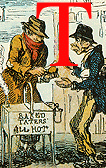
he word VALUE, it is to be observed, has two different meanings, and sometimes expresses the utility of some particular object, and sometimes the power of purchasing other goods which the possession of that object conveys. The one may be called 'value in use;' the other, 'value in exchange.' The things which have the greatest value in use have frequently little or no value in exchange; and, on the contrary, those which have the greatest value in exchange have frequently little or no value in use. Nothing is more useful than water; but it will purchase scarce any thing; scarce any thing can be had in exchange for it. A diamond, on the contrary, has scarce any value in use; but a very great quantity of other goods may frequently be had in exchange for it.
In order to investigate the principles which regulate the exchangeable value of commodities, I shall endeavour to shew,
First, what is the real measure of this exchangeable value; or wherein consists the real price of all commodities.
Secondly, what are the different parts of which this real price is composed or made up.
And, lastly, what are the different circumstances which sometimes raise some or all of these different parts of price above, and sometimes sink them below, their natural or ordinary rate; or, what are the causes which sometimes hinder the market price, that is, the actual price of commodities, from coinciding exactly with what may be called their natural price.
Bibliography
Adam Smith's An Inquiry Into the Nature and Causes of the Wealth of Nations. London: T. Nelson & Sons, 1852. Project Gutenberg. [EBook #38194]
Last modified 7 May 2019